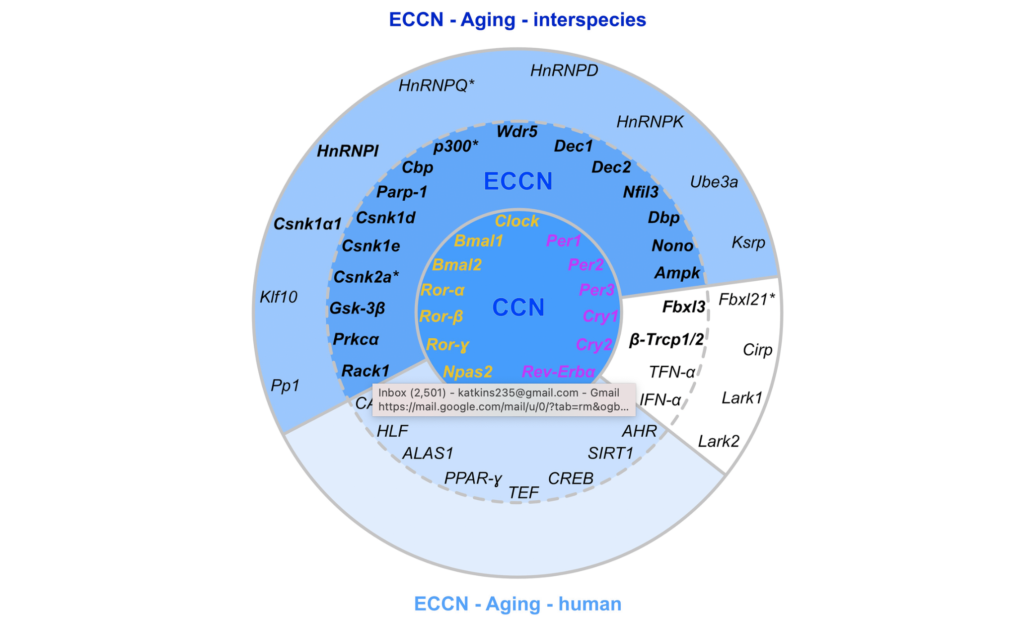In the Aging (Aging-US) Volume 13, Issue 24, cover paper, researchers conducted a study suggesting that the circadian rhythm is subjected to aging-related gene alterations.

Chronobiology is the study of biological rhythms. The human circadian system is a biological process known to regulate the sleeping and waking cycle (circadian rhythm; CR). Components of the circadian system are known as clock genes. Clock genes generate daily oscillations of gene expression and interact as an intricate network to influence biological processes in organisms, tissues and cells. This system is primarily regulated by Earth’s day and night cycles (light and darkness), though it can be affected by other factors, including nutrition, cellular devices, stress, illness, jet lag, and aging.
“It is well established that aging interferes with the regulation of the circadian system, which, in return, contributes to the manifestation and progression of aging-related diseases (reviewed in [4, 5]).”
Across an organism’s lifespan, changes in circadian rhythm take place. These changes can cause aging-related diseases to become more prevalent. Studies have also shown that age-independent alterations to the circadian system can result in premature aging. This interrelation between aging and CR means that aging may play a role in the circadian system and that the circadian system may play a role in aging. However, researchers have not yet fully illuminated the impact of aging-related circadian system changes on healthy organs and tissues.
“Whether aging-related changes of the circadian system’s regulation follow a conserved pattern across different species and tissues, hence representing a common driving force of aging, is unclear.”
The Study
In an effort to identify circadian rhythm regulatory patterns over the course of aging, researchers—from Friedrich Schiller University Jena, FLI Leibniz Institute for Age Research, Jena University Hospital, German Center for Integrative Biodiversity Research, and European Virus Bioinformatics Center—performed inter-species and inter-organ transcriptional analyses. The research paper was published in December of 2021 as the cover of Aging (Aging-US) Volume 12, Issue 24, and entitled, “Age-dependent expression changes of circadian system-related genes reveal a potentially conserved link to aging.”
“Here, we used RNA-Seq data to profile the regulation of CR-related genes of 4 different species in a cross-sectional study in individuals ranging from young mature to old-age categories.”
In this cross-sectional study, the researchers used data from 329 RNA sequencing libraries to identify differentially expressed genes in transcriptional profiles among humans, house mice, zebrafish, and the extremely short-lived turquoise killifish. All human donors were classified into the following age groups of 14 to 15 individuals: mature (24–29 years), aged (60–65 years), and old-age (75–79 years). The other species were categorized into their respective age groups. Organs, including the brain, blood, liver, and skin, were examined and then compared between the four species.
The researchers found that two circadian rhythm-related genes (dec2 and per2) were altered in all four species, primarily in early- and late-aging groups. Four genes (cirp, klf10, nfil3, and dbp) with aging-related expression patterns were found in several organs and species. In total, the researchers identified six genes (in several tissues from at least three out of the four species) that function at all regulation levels of circadian rhythm with apparently conserved age-associated regulation.
Conclusion
“Thus, these genes might represent a conserved link between the circadian system and aging.”
This study confirms work from previous studies and extends them by providing a new dataset linking circadian rhythm factors to physiological aging across four evolutionarily distinct species. Whether circadian rhythm regulation is the cause or a consequence of the aging process still remains to be explored. The researchers note that their non-synchronized cross-sectional approach should be replicated in the future and include an additional dataset based on a longitudinal study design, tissue synchronizations across species of interest and to potentially analyze anatomic sub-regions of the brain.
“In summary, our results show that modulations in CR-related gene transcription throughout aging are a conserved trait that is traceable across evolutionarily diverse species, ranging from humans to mice and fish.”
Click here to read the full research paper published by Aging (Aging-US).
AGING (AGING-US) VIDEOS: YouTube | LabTube | Aging-US.com
—
Aging (Aging-US) is an open-access journal that publishes research papers bi-monthly in all fields of aging research and other topics. These papers are available to read at no cost to readers on Aging-us.com. Open-access journals offer information that has the potential to benefit our societies from the inside out and may be shared with friends, neighbors, colleagues, and other researchers, far and wide.
For media inquiries, please contact [email protected].